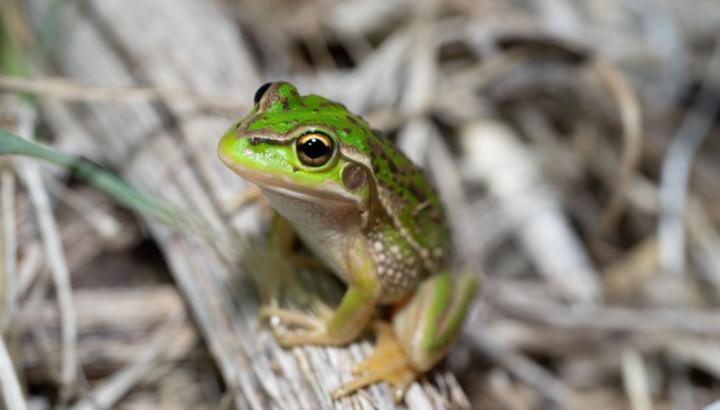
Wetland rescue: Melbourne Water brings growling grass frogs back to life
On a sunny spring day along Melbourne’s Merri Creek corridor, the unmistakable “growl” of growling grass frogs has returned to a swamp that had been dry just weeks earlier.
A pioneering habitat restoration trial, conducted by Melbourne Water and funded by the Victorian Government’s Nature next door Melbourne Strategic Assessment (MSA) Program, has brought the site back to life by mimicking natural wetland hydrology.
This in turn created a breeding habitat for growling grass frogs. The exact location is being kept confidential to protect the vulnerable species.
Protecting the growling grass frog advances Melbourne Water’s core mission by restoring connected, resilient waterways and wetlands, aligning operational water management with clear biodiversity, community and cultural outcomes.
Melbourne Water worked with Yarra Valley Water and the City of Whittlesea to design and deliver a temporary pumping solution under the MSA’s Growling Grass Frog Program.
In the trial, conducted from October 2024 to March 2025, nearly 10 megalitres of water was gently introduced to the swamp, re-establishing submerged and floating vegetation that provides breeding and foraging habitat.
Melbourne Water also carried out complementary works to support the trial by removing large woody weeds along the adjacent creek corridor. This exposed pools in the creek to sunlight which created warm basking areas for the frogs.
“To my knowledge, this is the first addition to the frog population in this wetland in 25 years, which is a brilliant outcome,” said Dr Geoffrey Heard, Research Fellow at The Australian National University and Science Advisor at The University of Queensland.
“Active management of off-stream breeding wetlands is precisely what growling grass frog populations in Melbourne’s growth corridors need to survive.”
Key outcomes:
- 160+ growling grass frogs detected in one night
- 5-month trial successfully mimicked natural wetland hydrology
- Melbourne Water will eventually be managing about 90 dedicated growling grass frog habitat wetlands under the MSA Program, as urban development proceeds
- Melbourne Water will also maintain about 2,000 hectares of conservation land secured for long-term growler protection.

“It was thrilling to see how quickly the growlers have moved in and made the most of their new home,” said Jane Petch, a freshwater ecologist employed at Melbourne Water as a Waterwatch Coordinator.
“The success of the watering project demonstrates how carefully planned habitat interventions are critical in the recovery of growling grass frog populations,” said MSA Director Claire Smith.
Dr Zoe Squires, MSA’s Growling Grass Frog Program Coordinator, said: “It was wonderful to witness hundreds of growler recruits actively foraging along the banks of this seasonal herbaceous wetland.
“The ecosystem has come alive and now supports a wide range of additional species. This result reflects the value of the Nature next door MSA Program and the dedication of the Melbourne Water Growling Grass Frog team.”
Once widespread across south-eastern Australia, growling grass frogs have retreated due to urbanisation, altered hydrology, disease, and drought. Melbourne Water’s trial demonstrates a practical approach to reinstating high-quality habitat in other priority wetlands.
Melbourne Water will refine pumping techniques and efficiency measures based on the results of this trial, using new site survey data to more accurately estimate water demand and reduce pumping volumes in future projects.
Media contact:
03 9679 7004
[email protected]



